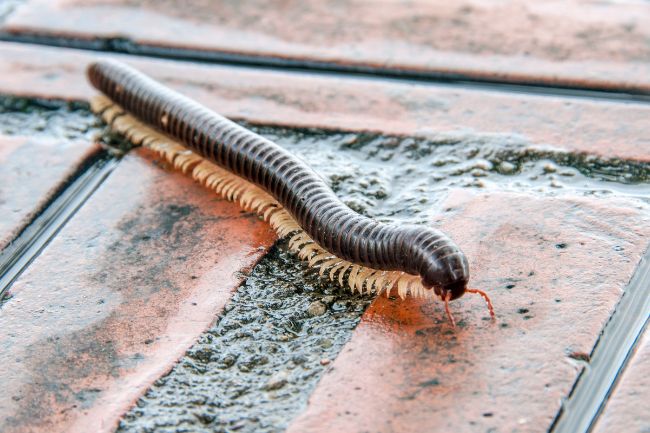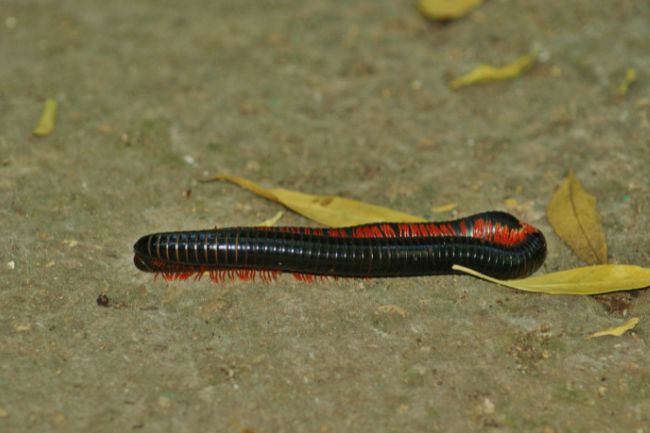Millipedes start their life as an egg, which hatches into a nymph that has fewer legs than adults. Once mature, they will find another adult to mate with.
Contents
What is a millipede’s lifespan?

There are around 16,000 species of millipedes across the world. They range widely in their size and in where they live, and because of this their lifespan also ranges a great deal. Some species live as little as two years, while others, like the giant millipedes can live up to ten years.
| Lifespan | Description |
|---|---|
| Variable Lifespan | The lifespan of millipedes can vary depending on factors such as species, environment, and conditions |
| Typically 1-10 years | Millipedes generally have a lifespan ranging from 1 to 10 years, although some species can live longer |
| Longevity Factors | Factors that can influence millipede lifespan include habitat quality, availability of food, and predation risk |
Also read: Here’s How Big Millipedes Are – Around the World
How do millipedes reproduce?
Millipedes sexually reproduce, meaning that it requires a male and female to produce young. Some species can asexually reproduce, however, this is very rare. Asexual reproduction means a female can lay viable eggs without having mated with a male, and will therefore create clones of herself.
Males and females find each other through the use of pheromones, chemicals they produce to attract a mate.
| Reproduction Type | Description |
|---|---|
| Sexual Reproduction | Most millipedes reproduce sexually, with male and female individuals engaging in courtship and mating |
| Fertilization | Internal fertilization occurs, where males transfer sperm to females for fertilizing the eggs |
| Egg-laying | Female millipedes lay eggs, usually in soil or decaying organic matter, providing a suitable habitat |
| Offspring Quantity | Millipede species can vary in the number of eggs laid, ranging from a few dozen to several hundred |
Males will often perform a mating ritual, such as a kind of dance, to show the female his prowess. In some species, the males also stridulate, meaning that they rub their legs on their exoskeleton to create a noise to attract a female. This is the same method as used by grasshoppers.

Once males and females find each other, mating can occur. The male will hold on to the female. In some species, the males might drum on the female’s back with their legs, until she allows him to mate. During the mating process, males use modified legs called gonopods to transfer packets of sperm called spermatophores across to the female.
A small number of species practice a different kind of reproduction, with the males creating a web, where he leaves his spermaphore. He will then attract in the female and she can collect the package herself, without direct mating occurring.
In some species the male and female will mate repeatedly. After mating, the male will take no further part in family life, heading off to find more females to mate with.
| Stage | Description |
|---|---|
| Egg | The initial stage of the millipede life cycle, where eggs are laid by adult female millipedes |
| Nymph/Larva | The hatched millipede offspring that resemble miniature versions of adults |
| Juvenile | Young millipedes that undergo several molts and grow in size |
| Adult | Fully developed millipedes capable of reproduction and completing the life cycle |
Do they lay eggs?
Once females have been mated with, they will head off to lay their eggs. Millipedes lay their eggs in the soil, some laying them in small burrows, in clusters, while others lay them individually. The number of eggs they lay varies a great deal between different species, but they can lay up to 300 eggs.
What do the eggs look like?
Millipede eggs are largely small, round and white. Some species create egg cases, made of feces or silk, but most lay eggs without any covering.
Parental care
The majority of millipedes lay their eggs and promptly abandon them to hatch into the world alone. However, Brachycybe lecontii is well-known for taking care of the eggs until they hatch, keeping them clean and protecting them from predators.
Instars
Millipedes hatch out after several weeks, however, they aren’t quite the millipedes we would recognise yet. In order to grow into adults, millipedes need to go through several growth stages or instars. Most millipedes hatch out without any legs and only get their first three pairs after they have their first two moults. These moults allow the millipede to shed off their skin, in order to grow.
Young millipedes need to go through several instars, so they can grow into a full adult. With each moult, millipedes can gain more and more legs and more segments. These changes can take several years. These young millipedes spend their time mostly within the soil, feeding on rotting plant matter or fungi.
Adults
Once the young millipedes have gained their full size, they will move out of the soil, and come to the surface to feed. Most adult millipedes feed on decaying organic matter, such as leaf litter and rotting wood, but some species will also eat a variety of insects.
Millipedes mostly live in damp and dark places, as they struggle with water loss. They do not have many defensive strategies, other than avoiding predators by remaining hidden. They can also exude noxious substances to put predators off trying to eat them.
Millipede species
Across the world there are many different millipede species, that live in different habitats.
Shocking pink dragon millipede
Possibly the most imaginatively named millipede, the shocking pink dragon millipede, is as eye-catching as its name suggests. A bright pink colour, it grows to 3cm in length and lives in limestone caves in Thailand.
Chocolate millipede
The chocolate millipede really does have a colouring reminiscent of milk chocolate. Found in the savannahs of Ghana, it can grow up to 25 cm in length and is one of the giant millipedes. It is one of the few millipedes that eats meat as well as plant matter.
Kentish pin-head
A yellowish brown millipede with a pointy head, this millipede is adapted to push its head through the soil. They are often found within woodlands and grow to around 18 mm long.
Flat-backed millipede
The flat-backed millipede is unusual, as it is much flatter than most species of millipedes. It is thought this flatter body helps it squeeze into cracks between rocks.
African giant millipede
The African giant millipede is the largest known millipede, reaching 33 cm in size. This giant millipede can live to up to 10 years, and can be found across East Africa.
Red millipede
The red millipede is so named because of its vibrant red colour. Growing to 9 cm in length it is naturally found across Mozambique.
Millipede family life
Millipedes are busy little critters that tend to live fairly solitary lives. Generally, their main aim is to eat but not be eaten, something which can be a challenge given how small and defenceless many species are.
However, between this solitary existence they do find time for a little romance, in order to keep the future generations going. And though we may not think of them as particularly loving creatures, the males really do seem to woo their females, even if the sentiments are often short-lived.
And from this brief courtship many tiny legged creatures head forward into the world, to scurry around under rocks and creep through the undergrowth.

